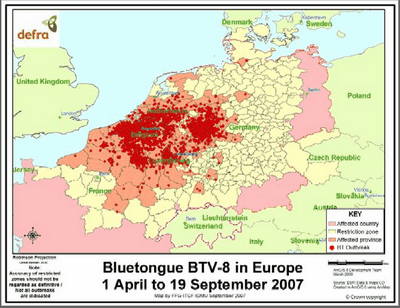Bluetongue (blue tongue) outbreak in the UK – FWi’s special report

On this page FWi brings you:
- Practical advice for preventing Bluetongue in livestock
- Information on Bluetongue symptoms
- Latest news headlines on the Bluetongue outbreak
- Background information about Bluetongue
Practical advice for preventing Bluetongue in livestock:
Some simple husbandry changes and practical midge control measures may help break the livestock infection cycle of Bluetongue disease:

- Housing livestock during times of maximum midge activity – from dusk until dawn – will significantly reduce biting rates and potential likelihood of infection
- Protecting livestock housing openings with fine mesh netting or coarser material impregnated with insecticide
- Tackling potential midge breeding grounds and use of pour-on insecticides approved for use on sheep and cattle may reduce risk of infection to some degree in certain circumstances
- Identify and destroy midge breeding sites – the Culicoides midges that carry the virus usually breed on animal dung and moist soils, either bare or covered in short grass. Turning off taps, mending leaks and filling in or draining damp areas will help dry up breeding areas. Dung heaps and straw bedding should be removed at least weekly to break the immature midge breeding cycle
- Apply insecticides approved for use on sheep and cattle – the DEFRA technical review on Bluetongue maintains that targeted use of synthetic pyrethroids – such as deltamethrin, applied weekly in and around animal housing and directly onto the target animals – should be effective as a practical disease defence strategy. But farmers need to speak to their vet about using insecticides as their use for midge control is off label and meat withdrawal periods will need modification. If you are using Coopers Spot On at weekly intervals, observe a 29-day withdrawal period for cattle and 63 days for sheep. The zero withdrawal period for milking dairy cows is unchanged
(Advice courtesy of Schering-Plough livestock vet adviser Paul Williams)
Click here for information on Bluetongue symptoms
Background information about Bluetongue:
What is Bluetongue?
Bluetongue is an insect-transmitted virus which can kill up to half of infected sheep and approximately 1% of infected cattle
Are there movement restrictions in place because of Bluetongue?
It’s complicated but you can keep up to date here
What insects are involved?
Culicoides oboletus and pulicaris midges carry the disease and can infect animals through a single bite
What strain of Bluetongue is in the UK?
The strain is type 8 – the same strain as found across northern Europe, but not the same straiun affecting southern Europe. The type 8 strain is thought to have originated in Africa, but how it got to northern Europe no-one is sure

How did it get here?
Bluetongue has been spreading across northern Europe since late 2006. It is likely a population of midges was blown across from Germany, the low countries or north-east France
Is it likely to devastate the UK livestock industry?
One thing in our favour is that now we are into autumn, temperatures are falling. The virus cannot replicate below 15 degrees C.
Is there a vaccine?
Yes a vaccination programme has been underway since May 2008 across England. Farmers in Wales began vaccination in early September. While no decision has been made on when Scottish farmers will be able to vaccinate.
